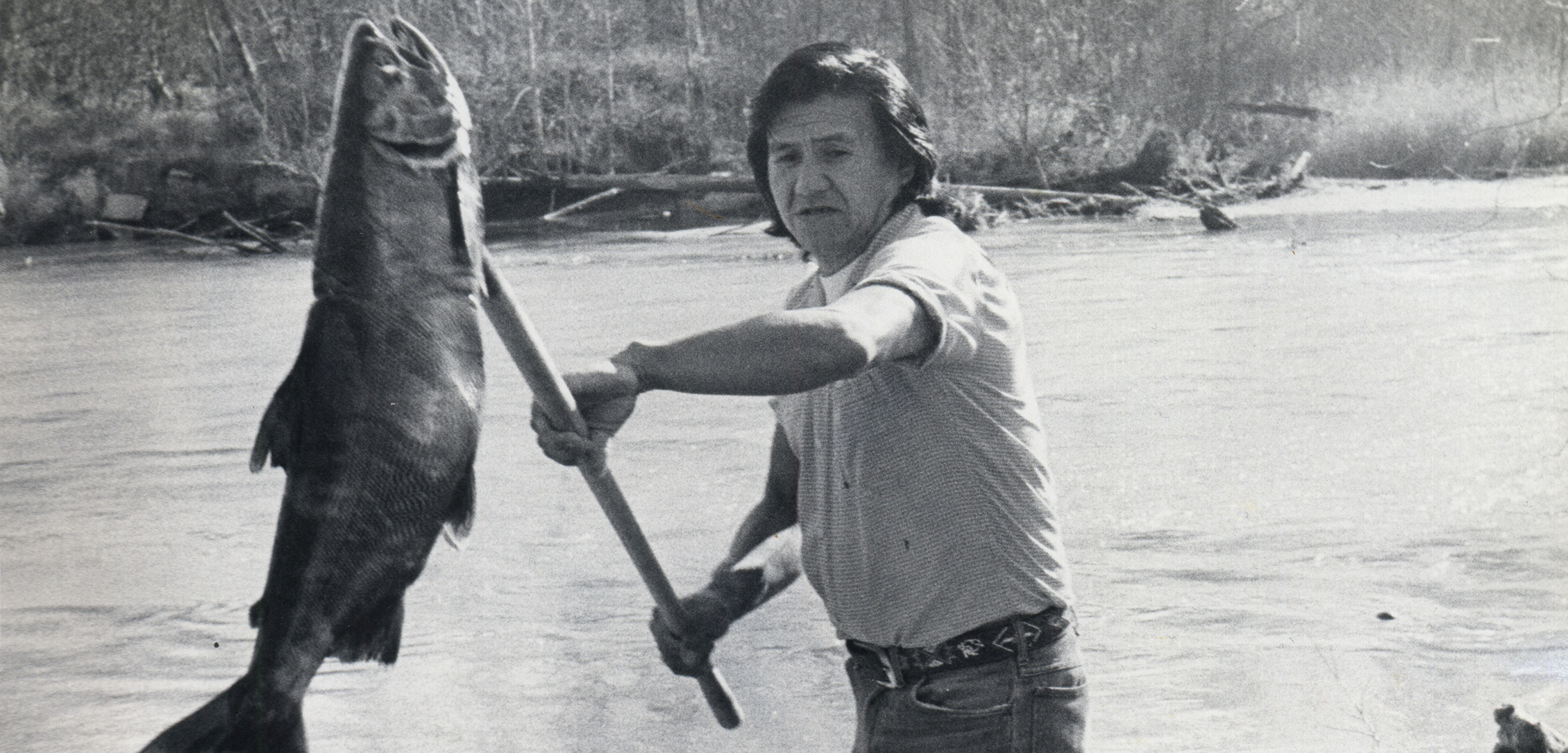Tribal Hatcheries and the Road to Restoration
In the US Pacific Northwest, tribal hatcheries uphold Indigenous communities’ treaty rights to salmon, while buying time to rehabilitate lost habitat.
Article body copy
The Nisqually is a salmon river. Fueled by glaciers on towering Mount Rainier, the river flows west and north for about 130 kilometers across western Washington State, springing from a national park, then journeying through timberlands and towns, municipal dams and farmlands, a tribal reservation and a military base, before rendezvousing with salty Puget Sound in a national wildlife refuge. The river was once home to thriving wild runs of four Pacific salmon species—chinook, chum, coho, and pink—or five, if you count their cousin, steelhead. Traditionally, on chilly January afternoons like today, when the low winter sun burnishes sky and water a brilliant blue, Nisqually fishermen would be pulling chum from their nets. Chum would run the river from November to February, sustaining the tribe during the long, gray winters. But like so many things in recent years—say, global health or political sanity—this rare run of all-wild fish is also declining.
The Nisqually Indian Tribe, whose homeland hugs the river, hasn’t held a proper fishing season for chum in years, says tribal chairman Willie Frank III.
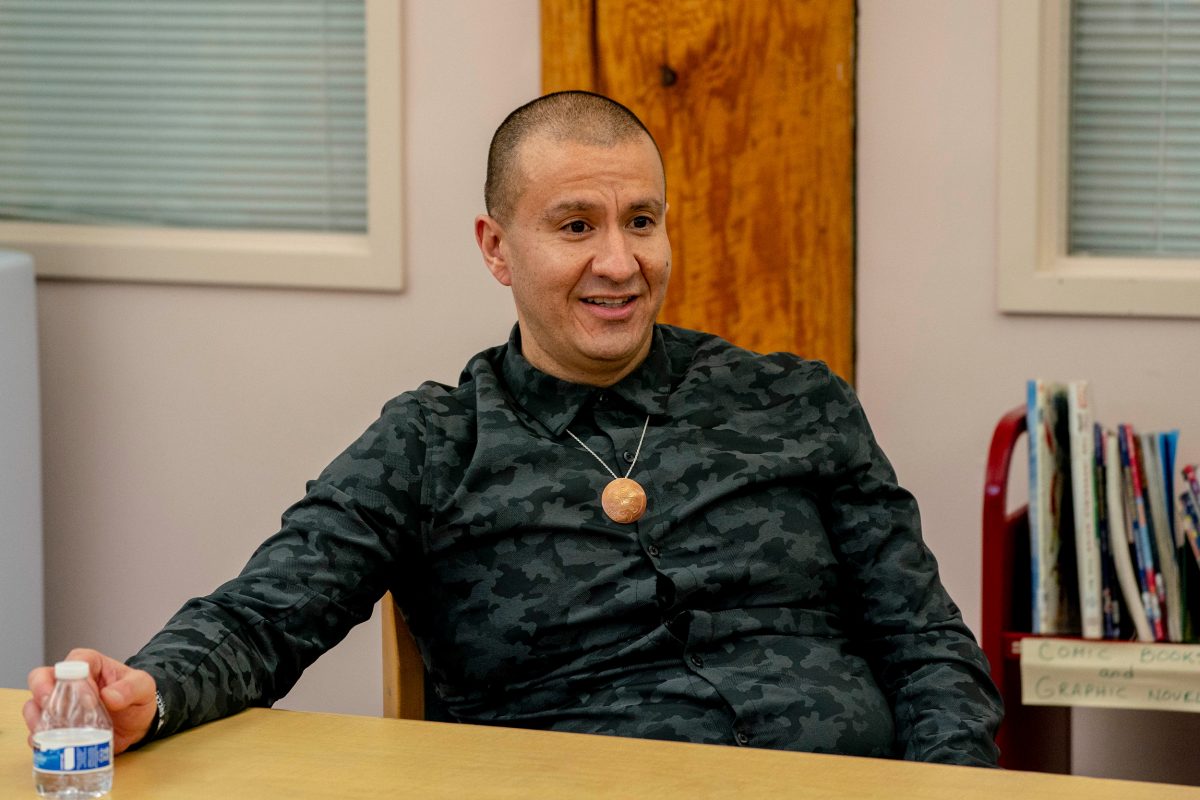
Nisqually tribal council chair Willie Frank III is the son of Billy Frank Jr., an advocate for Native American treaty rights in Washington State. Photo by David Ryder
Frank III, tribal council member Hanford McCloud, and I had planned to be sitting in a boat, touring the river. High water levels, however, have stranded us on land. After introductions to the Nisqually Tribal Council on a wooded curve of riverbank known as Frank’s Landing—named for Frank III’s grandfather—we head into the library of the Wa He Lut Indian School. Amid the blare of a disembodied voice reminding us that a certain child needs to catch a waiting bus, McCloud opens up about the Nisqually’s reliance on hatchery-born salmon, at once a welcome lifeline and a troubling omen.
“My take on hatcheries,” McCloud begins, “is [like] being cornered into the back of the room.” To honor their traditional heritage, the Nisqually need salmon. With healthy salmon habitat in short supply these days, the Nisqually need hatcheries. Having no choice but to rely on hatcheries is “not something we asked for,” he says.
The Nisqually not only need salmon; the United States government owes it to them, a promise made in exchange for the land where we now stand. But their situation is familiar to other Indigenous communities in Salmon Nation, the world that today encompasses the northwest of the United States, British Columbia, and Alaska.
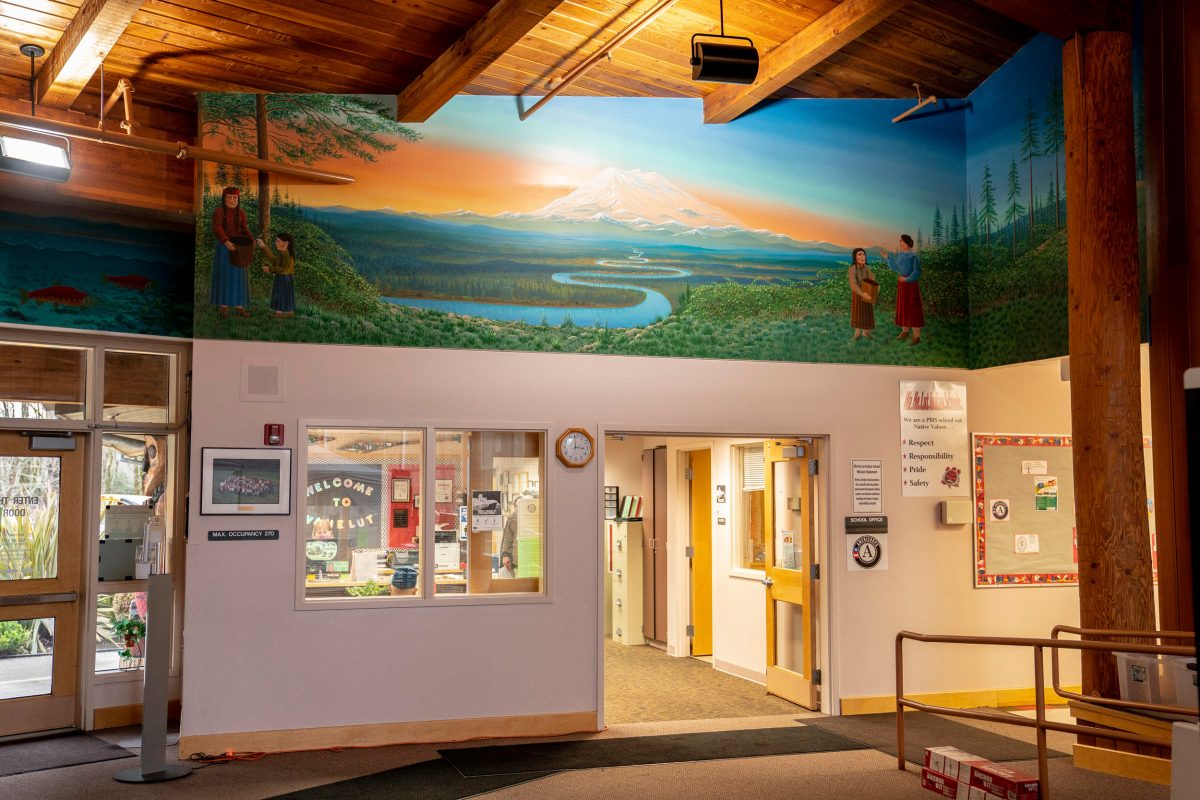
The Frank’s Landing Indian Community founded Wa He Lut Indian School in Washington State in 1974 to ensure that Native American children would get the education promised in the Treaty of Medicine Creek. Photo by David Ryder
The Nisqually is one of many tribes with their backs shoved against the concrete wall of challenges that salmon face today, and so they, too, have resorted to hatcheries—facilities where humans direct salmon sex, fertilizing eggs in plastic buckets and giving naive young salmon a head start before their journey through an untender world. In the past, hatcheries have been implicated in Pacific salmon declines—issues tribes in western Washington first started addressing in the late 1990s. “Hatchery-raised fish can interbreed with wild salmon and weaken the fitness of wild stocks and they also can compete with wild salmon for food and other resources,” Washington’s 2020 State of Salmon in Watersheds report notes, before detailing ways hatcheries can reduce such interference. But despite the genetic and ecological risks to future salmon populations, for the Nisqually and many other tribes, no hatcheries would mean practically no salmon. It’s untenable.
McCloud, in his mid-40s with gray streaking his beard and long, dark hair, remembers growing up fishing with his father on a nearby river. They used to spend half the year or more scooping salmon into their nets. And then, like a mini assembly line, they filleted, smoked, and canned the oily flesh. “It’s like breathing for us, me and Willie,” McCloud says, gesturing to Frank III, seated next to him among the children’s library stacks. “Now, we’re lucky to get 30 days on a river if it’s available.” Though in a bad year—and there have been many lately—fishing can be limited to as few as eight days. Hatcheries are helping stall the loss of salmon for tribes, but only to an extent. “Seeing that change over my lifetime is very traumatic,” he adds.
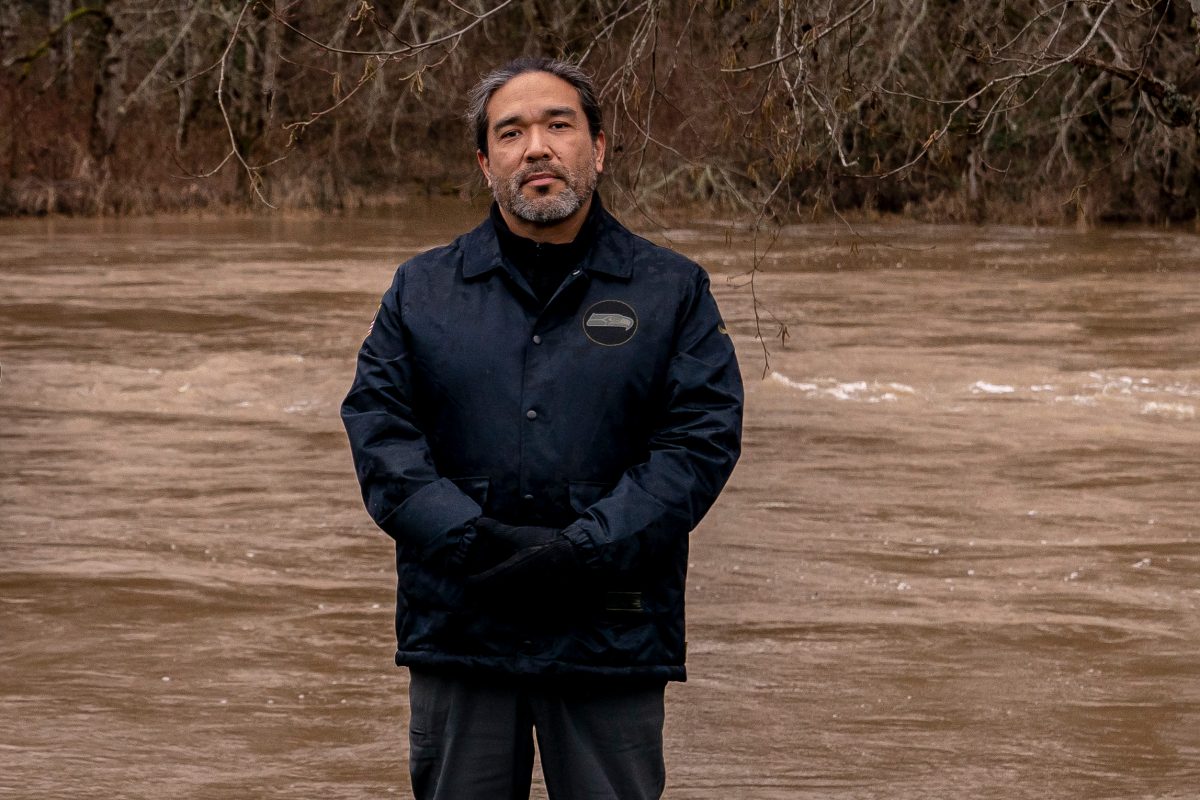
Nisqually tribal council member Hanford McCloud grew up fishing with his father. Photo by David Ryder
Like Indigenous peoples throughout the region, the Nisqually are salmon people, protectors of the sacred fish that have nourished them and the land physically and spiritually for time untold. And like many Indigenous communities (as well as government agencies in the United States and Canada), they operate their own Pacific salmon hatcheries. And just like other salmon people, the Nisqually fiercely defend their rights to those fish—an ageless legacy guaranteed by treaties nearly 170 years old—whether that’s in the courts, in conference rooms, or like the Frank and McCloud families during the Fish Wars of the 1960s, while being dragged by game wardens from riverbank and boat, hands still gripped around fishing nets.
Despite their treaties, however, pavement now shrouds the streams and shores of past salmon paradise. Millions of people populate the northwest and are unlikely to bulldoze their pricey waterfront homes or businesses to make way for salmon habitat. Today, the majority of salmon returning to Puget Sound were born with human help. Hatcheries, while not universally popular given their potential to complicate wild salmon recovery, represent part of society’s historical bargain for trading salmon streams for Starbucks. And for tribes that have already been subjected to the ongoing trauma of colonization, these artificial salmon nurseries act as a balm for these larger wounds as the slow, difficult work of healing the land unfolds.
Hatchery fish are the salmon the nations have, and even hatchery fish need a home. All salmon need clean, cool water, food, and places to grow and rest as they travel from stream to the open ocean and back again. And long ago, tribes here put their names on binding agreements with the understanding that salmon always would have a home, even as the tribes gave up their own.
As far back as the 1870s, cracks were already appearing in some of the legendary fish runs that range from Northern California to Alaska. Salmon be damned, it was boom time for mining, logging, fishing, farming, ranching, and, of course, damming rivers for power. And damned the fish were.
Some scientists began making noises, and US Fish Commissioner Spencer Baird declared in 1875 that the three major threats to Pacific salmon fisheries were overfishing, altered habitat, and dams. But he was confident that, rather than regulating the fishing industry, building hatcheries would more than make up for the other risks. In 1895, just six years after achieving statehood, Washington built its first hatchery on a tendril of the mighty Columbia River—nearly 20 years after Oregon’s first. More hatcheries quickly followed, around 150 in Washington alone, popping up like gas stations along riverine highways, at first attempting to refuel declining salmon stocks with pure factory-style volume.
Nowadays, for aims ranging from harvest to conservation, US federal, state, and tribal hatcheries inject 310 million salmon into waters along Puget Sound, the Washington coast, and the Columbia River basin each year. Tribes are relative latecomers to the scene, only receiving the funding possible to start their own hatcheries after the mid-1970s. By the late 1990s and early 2000s, US hatcheries began the ongoing process of overhauling management practices to minimize harm to wild stocks. For reasons varying from tribal values to federal funding and law, tribal harvests of hatchery fish today are tied to how well natural-origin stocks are faring. And those salmon stocks are not doing nearly as well as the big tech stocks that took their place here.
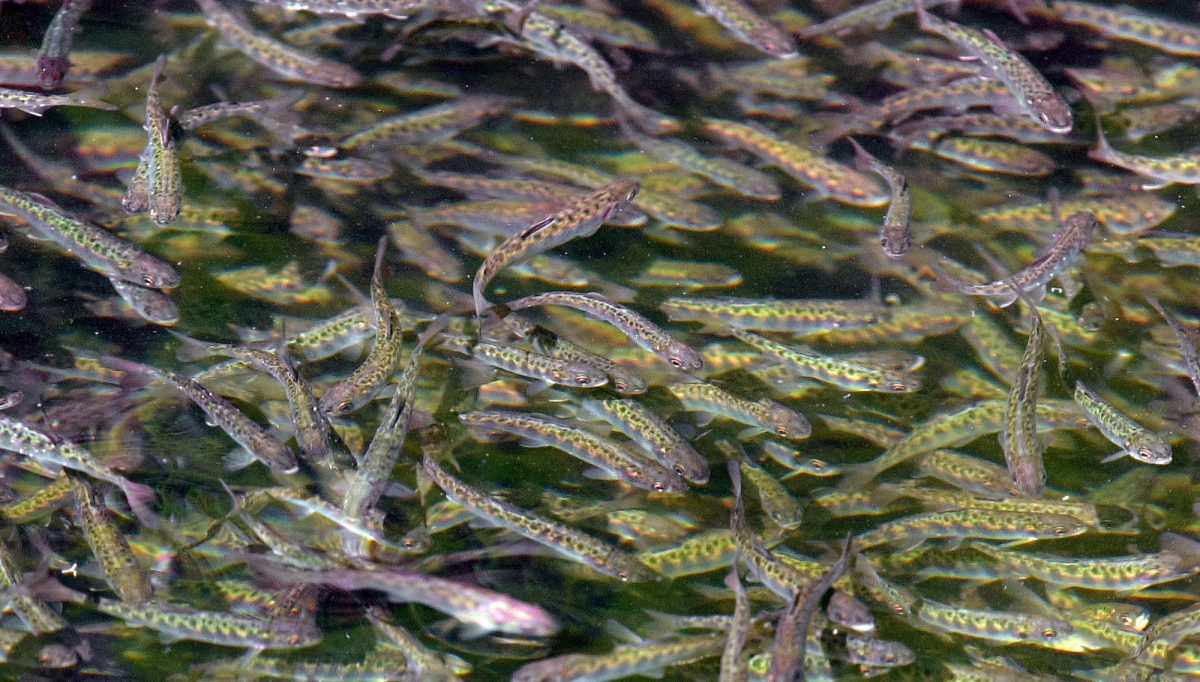
Hundreds of thousands of three-month-old chinook salmon swim fin to fin in fish hatcheries. Photo by Elaine Thompson/AP Images
Over a dozen salmon stocks in Washington are listed on the US endangered species list. In a typical year, for example, only 900 threatened chinook salmon return to spawn along the Stillaguamish River, which empties into Puget Sound less than 80 kilometers north of Seattle. Two-thirds of those fish are born inside a hatchery.
After the Stillaguamish Tribe shut down all fishing of this stock in the mid-1980s, they went decades without netting a chinook. Ancient knowledge, meanwhile, was draining from their people. Generations not practicing the songs, the places, the stories, the weight of nets in their hands leads to a collective forgetting. In 2009, fisheries manager and then–tribal council member Shawn Yanity pushed for the Stillaguamish to again practice their sacred—and legal—right to harvest chinook in order to bless the river and welcome back the fish. Last year, the Stillaguamish Tribe harvested a single ceremonial chinook. It’s not much, but even one ember can keep a fire burning.
“The importance of our hatchery is keeping our culture alive,” says Yanity. It’s also keeping this chinook run alive. But these days, even the returns of hatchery chinook are pitifully low. The tribe is undertaking ambitious habitat restoration efforts—softening the river’s hardened banks, allowing the straightedge waterway to again snake leisurely across the floodplain, re-creating salmon-friendly side channels—but the Stillaguamish River remains largely beset by agricultural dikes, logging, and development. Today, the river is lined with just 10 percent of its original riparian habitat. Yanity isn’t optimistic about current prospects for their wild chinook: “We’re flatlining.”
As the 20th century waned, tribes like the Stillaguamish increasingly turned to hatcheries, long the purview of the state and federal governments, as a form of salmonid first aid. But in trying to reset the heartbeat of the rivers, beleaguered tribes at times have been confronted by what they refer to as a vocal minority of salmon advocates.
“The hatcheries are facing challenges from lawsuits from organizations like Wild Fish Conservancy,” Yanity says. “They want hatcheries shut down because they just want to see wild fish.” He acknowledges the unfortunate reality that even fish conceived in a bucket need somewhere to live. As both humans and fish searching for decent real estate in the Pacific Northwest know, that’s no easy task. But closing down hatcheries, as a few groups suggest, would violate treaties and starve Indigenous peoples of the few salmon they have left.
“If we’re just going to be relying on wild fish, that means nobody’s going to be fishing,” says Yanity. And he means that for non-tribal fishers, too.
Wild Fish Conservancy, a Washington-based nonprofit which lists “sunsetting hatcheries” among its priorities, insists that it has in mind the best interests of healthy salmon and ecosystems. But the group points to “the failure of hatcheries” in producing those results. “It’s clear there’s more we can do to meet our moral and legal commitments to Tribal and First Nations, from restoring and protecting habitat, reducing hatchery impacts on wild fish, and addressing inequitable and unsustainable industrial harvest,” says Emma Helverson, Executive Director of Wild Fish Conservancy. “After over a century of broken promises, it’s time to prioritize solutions shown to recover resilient, self-sustaining populations.”*
Tribes like the Stillaguamish and Nisqually don’t envision hatcheries as the primary solution to their salmon woes; on the contrary, they have been shouting “habitat!” for decades at anyone who might listen—and many who haven’t.
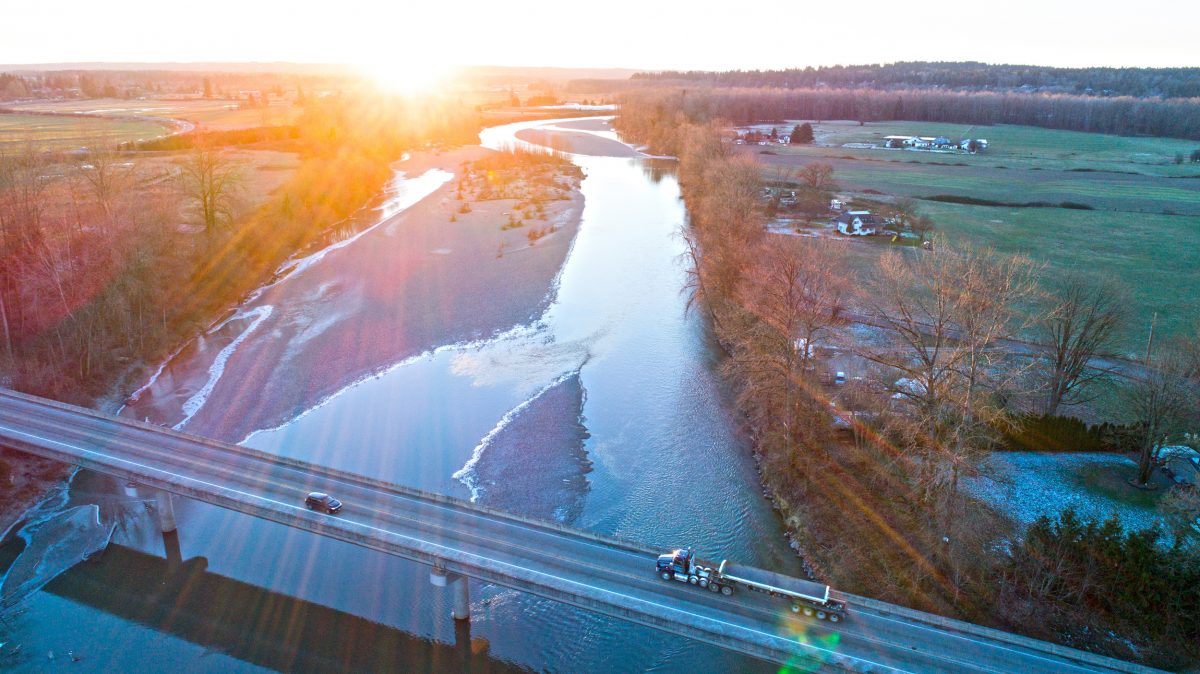
Only 900 threatened chinook salmon return to spawn along the Stillaguamish River, which empties into Puget Sound less than 80 kilometers north of Seattle, Washington. Photo by Seastock/iStockphoto
For instance, the Nisqually are acknowledged leaders in ecological restoration, thanks in no small part to Frank III’s late father Billy Frank Jr., a fisherman and Native American rights activist whose name now graces the nearby national wildlife refuge. The tribe has helped rebuild 90 percent of the Nisqually River estuary’s function and is also restoring the degraded forests and shorelines farther up the watershed. But such efforts need time, especially given the scale of destruction. McCloud emphasizes that the Nisqually’s two hatcheries, while not their ideal scenario, combat the ongoing injuries to salmon—and his tribe—during the gradual process of healing deep wounds. But not everyone has understood this point, including the conservation-minded outdoor gear giant Patagonia.
In 2019, Patagonia produced the film Artifishal, a pun on the artificial propagation of salmon in hatcheries. Frank III, with his close-cropped black hair and air of gravitas, makes a brief appearance in the film, as does one of the tribe’s hatcheries. The Nisqually say that the filmmaker described the documentary as exploring the need for hatcheries in an urbanizing environment. But to their shock—and anger—when the film aired, Artifishal didn’t seem to show any real need for hatcheries. Its tag line: “The road to extinction is paved with good intentions.” But as Frank III’s father and others have argued, the road to extinction was paved with greedy intentions—there was no political will to protect habitat or rein in overharvest when these were still feasible, long before tribes got involved.
For tribes, it’s a bit rich that for over 79 minutes the documentary harpoons hatcheries, lumping them with open-net-pen Atlantic salmon farms and characterizing hatcheries as “a system that’s driving wild fish to extinction.” In Artifishal’s wake, the tribe aired their grievances with Patagonia executives over what the Nisqually call their misrepresentation in the film. In the end, they managed to open the door for a potential conservation partnership with the outdoor retailer. Patagonia acknowledged the conversations with the tribe around the film but declined to comment.
Habitat restoration is front and center for Salmon Nation, as is keeping the fishing tradition alive. As his father and grandfather did before him, Frank III still fishes at Frank’s Landing with his brother. “I compare the Sundays when we’re fishing in the summertime to church. Really it is, it’s our church.”
Within that church, Frank III, now age 40, is an eager evangelist. “I’ve never had so many younger tribal members want to learn how to start fishing,” he says. “It’s about just being on the river.”
Overlooking the river at Frank’s Landing, Antonette Squally, elder and Nisqually council vice chairwoman, is clad in a traditional Native American ribbon skirt, long and black, patterned with roses and trimmed with pink silk ribbon. But she would be just as comfortable in less formal attire, setting fishing nets in the river. Now in her 50s, she recalls her early days of fishing. “I remember as a child, I earned my first [US] $100 bill with my little brother. We were seven years old, carrying a 70-pound [32-kilogram] salmon up the hill,” she says.
Her father was a fisherman, too. He cast his nets alongside Billy Frank Jr. in the mid-20th century, in an era when the State of Washington rewarded such actions anywhere outside of Native American reservations with physical violence, jail sentences, and confiscated gear. These were the Fish Wars, and they were a century in the making.

Antonette Squally, right, witnessed the violence of the Fish Wars firsthand as a child. Squally’s niece, Chay Squally, is pictured on the left. Photo by David Ryder
In 1854, on a late December day close to what would become Frank’s Landing, leaders of the Nisqually and eight other tribes and bands from around south Puget Sound gathered next to a creek. There, under the arms of fir trees, Washington territorial governor and superintendent of Indian affairs Isaac Stevens negotiated the Treaty of Medicine Creek, with the terms read aloud in Chinook, a trade language comprising all of 300 words. One phrase from that treaty would glow like an ember in the hearts of tribal descendants.
In essence, Stevens said the tribes were ceding their ancestral lands to the US government for a total price of $32,500 and agreeing to live on reservations. He would broker nine more treaties with other northwest tribes, garnering for an insatiable young America an area of rugged western real estate larger than the United Kingdom. But for tribes, one particular phrase from these treaties would make all the difference: “The right of taking fish, at all usual and accustomed grounds and stations, is further secured to said Indians in common with all citizens of the Territory.” In those 27 words, the tribes had enshrined in US treaty their right to keep fishing in their traditional places.
Treaties aside, the next century would hasten a different bargain—governments’ trade of healthy northwest salmon runs for unbridled industrial development. Old-growth timber fell. Farms and cities redirected rivers. Commercial fishing ran largely unchecked. And all the while, salmon populations faltered. Yet state officials cracked down on Indigenous people for fishing off reservations, even though treaties guaranteed that right. Turning a blind eye to the vast commercial harvests, state agents targeted the few tribal fishers waiting to welcome salmon back to the rivers where their ancestors had. Fishing gear confiscation, intimidation, and arrests—tribal fishers suffered it all in the name of conservation.
As a sign of the times to come, in 1945 state agents arrested Billy Frank Jr., then 14, for fishing at Frank’s Landing, the small family settlement and fishing post that lies off the Nisqually reservation. This was Frank Jr.’s first arrest, but far from his last.
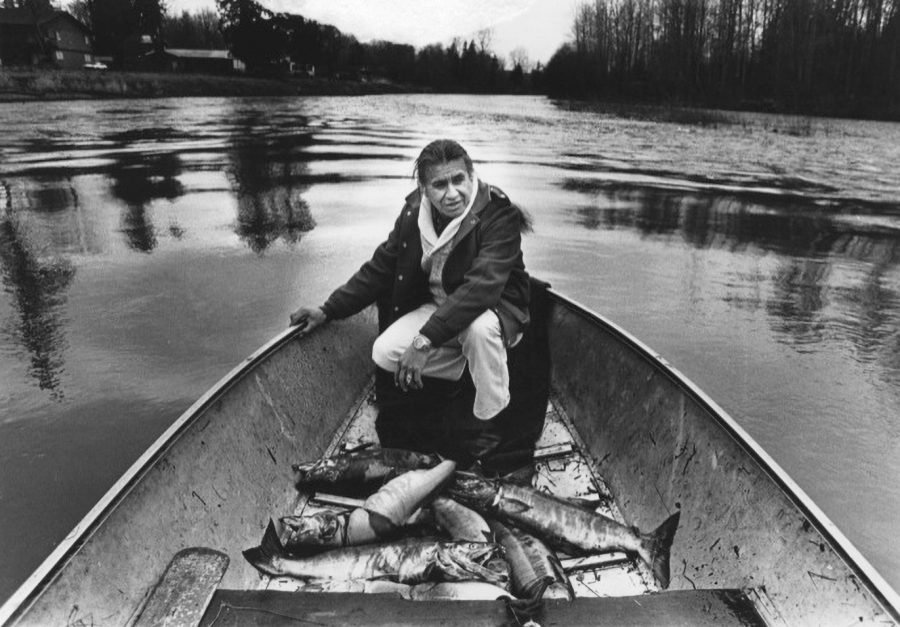
First arrested when he was 14 years old, Billy Frank Jr. pushed back against government officials as salmon populations faltered and state officials cracked down on Indigenous people for lawfully fishing off reservations. Photo by the Northwest Indian Fisheries Commission
“Our usual and accustomed grounds ran 80 miles [130 kilometers] from the mouth of the [Nisqually] River all the way up to Mount Rainier,” says Frank III. “And in the ’50s, ’60s, and ’70s, the state was trying to tell us how the treaty is to be interpreted … that we can only fish on the reservation boundary lines. And my father and many others said, ‘No, that’s not how this works.’ And that’s what started the fishing wars.”
By the 1960s, the sit-ins of the civil rights era inspired Native Americans at Frank’s Landing and throughout the northwest to stage “fish-ins” to rally media attention, celebrity appearances, and public support for treaty fishing rights. These divisive protests often featured clashes with state law enforcement, with so-called renegades like Frank Jr. usually hauled away to jail. The state would also commandeer what they deemed as illegal fishing gear, such as tribal gill nets and even Frank Jr.’s beloved hand-carved canoe. The tension between the state and tribes became as taut as a fish on a line—and this one was ready to snap.
Though just a child at the time, Squally witnessed up-close the Fish Wars.
“We did a fish-in [in] downtown Olympia when I was four years old,” she recalls. In the fall of 1968, along with others from Frank’s Landing, her father was setting the net in Capitol Lake when she saw a state officer’s billy club rain down on him. “I watched my dad get beaten—I mean, he was unrecognizable, his face was beaten so bad,” Squally recounts. Over 50 years later, the emotions remain raw. Battling for the soul of Salmon Nation leaves scars.
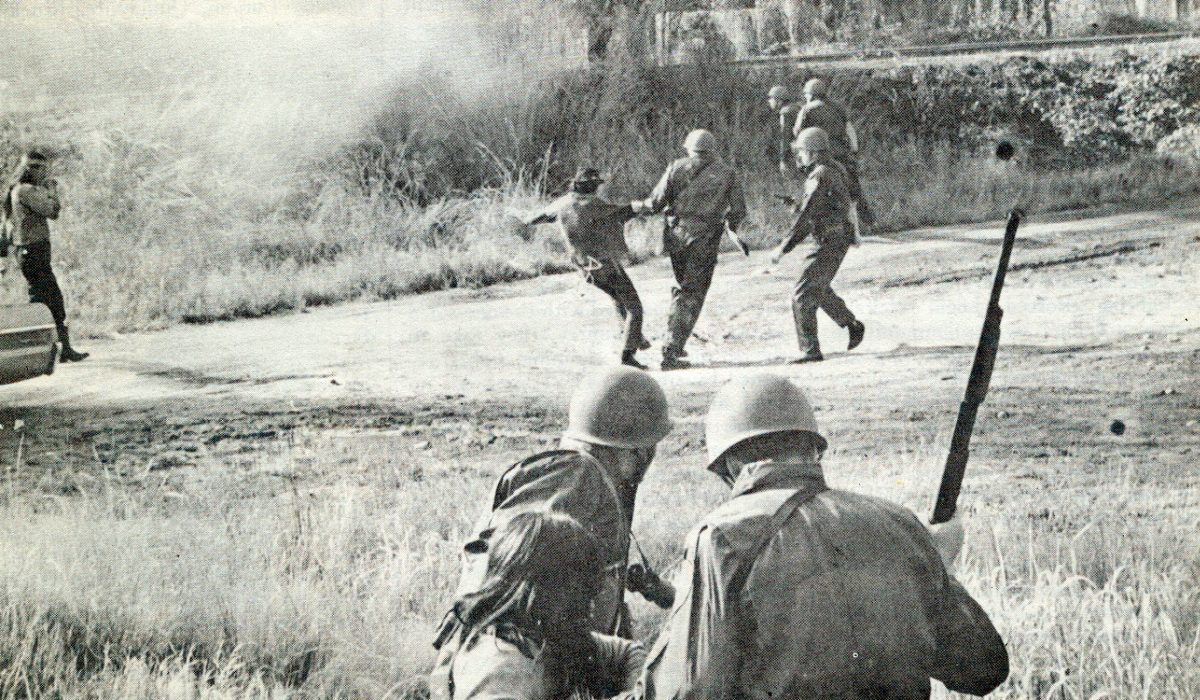
The Fish Wars could turn violent with state law enforcement physically beating Indigenous fishers for lawfully fishing at all usual and accustomed grounds and stations. Photo by the Northwest Indian Fisheries Commission
In direct response to the fish-ins, a dizzying volley of court cases erupted over the legal question of treaty fishing rights. A key case, US v. Oregon, was first decided in favor of the Nez Perce and three other tribes in the Columbia River basin in 1969. But the matter reached a decisive crescendo with US v. Washington in the court of federal judge George Boldt. Brought on behalf of the Nisqually and six other tribes, the case scrutinized the interpretation of that key phrase about fishing rights from the 19th-century treaties: “at all usual and accustomed grounds.” Judge Boldt’s 1974 ruling, known as the Boldt Decision, delivered an unexpected win for treaty tribes in western Washington and set a far-reaching precedent: it upheld treaty fishing rights off reservations, named tribes as co-managers of the fisheries, assured their right to half the annual catch, and overturned discriminatory fishing regulations. This sweeping decision inspired the judge presiding over the US v. Oregon case to later clarify even stronger treaty rights for tribes in eastern Washington and parts of Oregon and Idaho.
Yet the backlash was swift and furious. Washington at first refused to comply. Non-tribal fishermen hung Judge Boldt in effigy. But in 1979, the US Supreme Court affirmed Boldt’s decision. Still, by then so much damage had been done to wild salmon runs that tribes, with newly available federal funds, began building hatcheries. But was a hatchery fish considered a treaty fish, with all the associated rights for management and harvest?
In 1980, the courts said yes. And they added that the state and federal governments couldn’t erode this treaty right to fish by failing to protect salmon habitat from degradation. The treaties never envisioned fishing grounds becoming Interstate 5 or the Space Needle.

Billy Frank Jr., pictured here on the shore of Frank’s Landing, died in 2014, at the age of 83. Photo by Ted S. Warren/AP Images
Not far from I-5, on Puget Sound’s far northern coast, near the Canadian border, Lisa Wilson was still learning to fish when the Boldt Decision first splashed on the scene. Today, Wilson is a commissioner on the Northwest Indian Fisheries Commission and tribal council member for the Lummi Nation. “Hatchery fish have been deemed a treaty fish,” she stresses. “I’m so passionate about it because it’s what we have left to fight for.”
Tribes, however, still face pushback as they try to restore the salmon guaranteed to them by treaties. It comes from a range of sources, from governments and sport fishers to conservation groups and outdoor retail giants.
Puget Sound is only one former salmon powerhouse undergoing attempts to rebuild its crumbling aquatic ecosystems. The Columbia River runs about 2,000 kilometers from its headwaters in southeastern British Columbia along hooks and bends into eastern Washington and carves a gorge between Washington and Oregon before pouring its volumes into the Pacific Ocean. Salmon can travel one of the river’s many tributaries, the Snake River, to arrive in the traditional lands of the Nez Perce Tribe, which span southeastern Washington, northeastern Oregon, and Idaho. But for fish, that journey is too often met with early death.
For a salmon to return to Nez Perce country from the Pacific Ocean, it first has to muscle its way up the Columbia and Snake Rivers for at least an astounding 800 kilometers. But what makes that impressive journey so punishing today is that it requires clearing no fewer than eight dams. The consequences are devastating for natural-born and hatchery salmon alike.
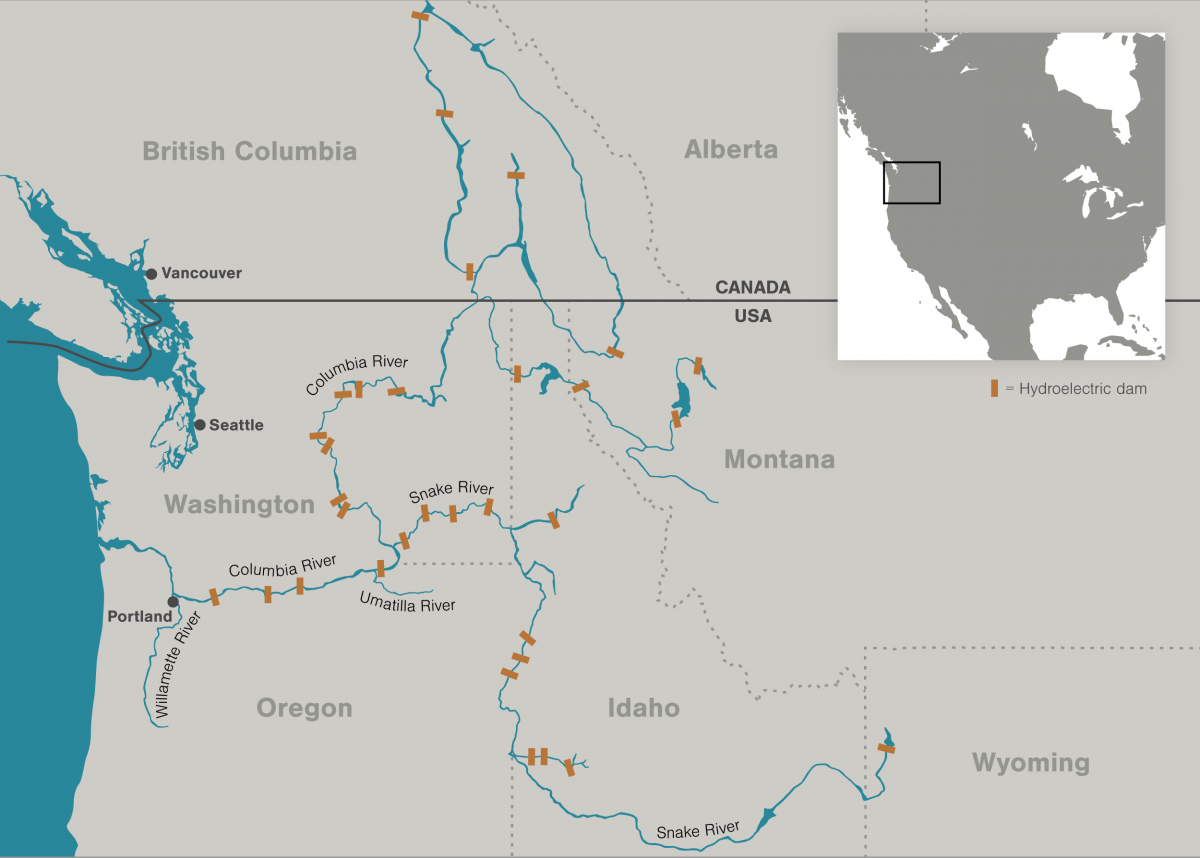
Dams have impeded salmon runs in Pacific Northwest rivers for over a century. Illustration by Mark Garrison
“They are just being hammered,” says Dave Johnson, Nez Perce fisheries manager and enrolled Navajo. “So the tribe has advocated for breaching the four lower Snake River dams.” According to Johnson, research suggests salmon survival could double if fish had to navigate only four dams. Just four.
For basically every dam along the Columbia and Snake, there is at least one corresponding hatchery. Government agencies and energy companies built most of these hatcheries based on a blind optimism that they would offset the problems that came with dams: blocking fish passage and flooding spawning habitat. The Nez Perce Tribe’s hatchery program, one of the newest in this region, produces around one-third of the young salmon coming out of the Snake River basin, and is particularly notable for its successes where so many others have failed: reviving lost salmon runs.
By 1986, wild coho had completely disappeared from the Clearwater River, a tributary of the Snake in north-central Idaho. In 1994, federal and state agencies announced that extra coho eggs from hatcheries on the lower Columbia—the river system’s last stronghold for coho—were available; did any of the treaty tribes in the region want them? The Nez Perce leaped at the opportunity. But instead of eight dams, now these salmon had to clear a new barrier—the State of Idaho.
Raising dubious concerns about potential disease, Idaho Fish and Game refused to issue the tribe a permit to bring in the fertilized eggs. A biologist who had just started working for the Nez Perce at the time recalls that the agency apparently threatened to send state patrol to make arrests as the eggs crossed the border. Undeterred, the Nez Perce, with help from the nearby Yakama Tribe, went ahead anyway. Over half a million eggs arrived without arrest, or disease. When it came time to release the young salmon, Idaho again “threatened legal incarceration” to Nez Perce staff. But it was another empty threat.
Now, some 25 years later, coho are once again barreling up the Clearwater River each fall, and the state and tribe are on much better terms. The salmon are still mainly hatchery offspring, but they’re a population strong enough to journey through eight dams and in numbers high enough to sustain tribal and non-tribal fisheries.
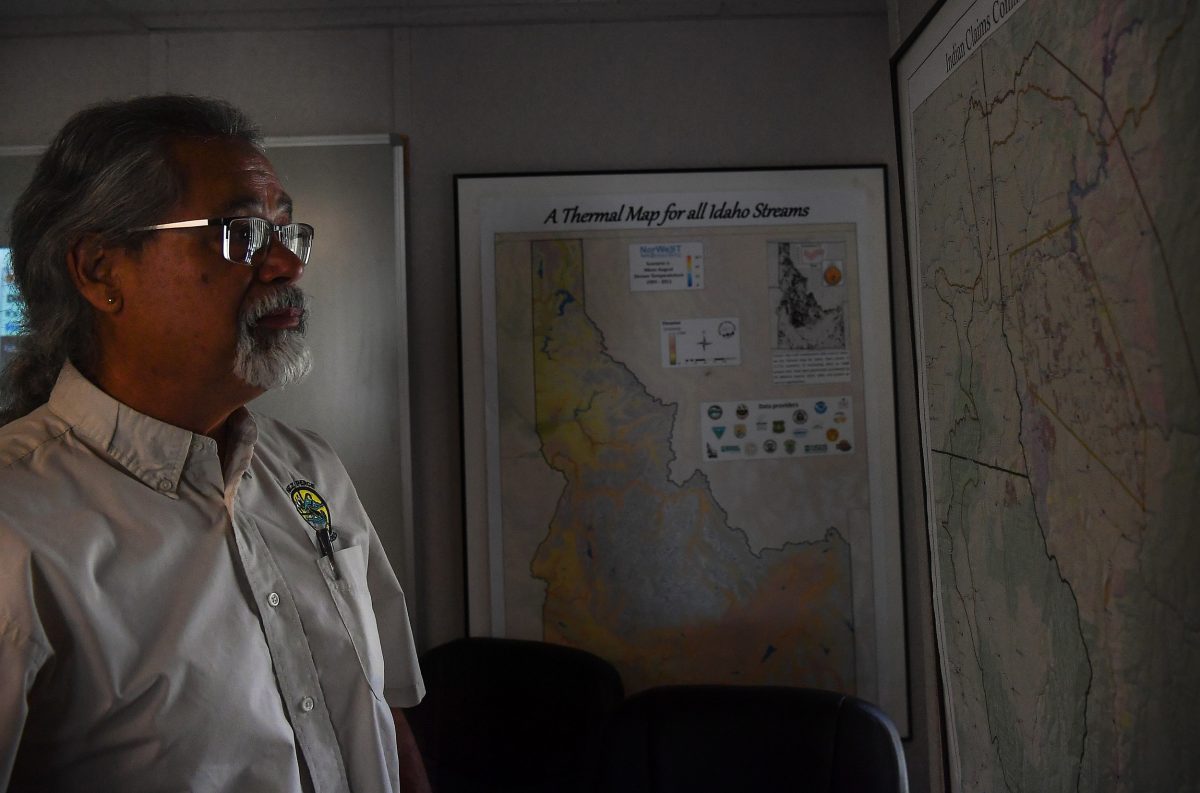
Dave Johnson manages fisheries for the Nez Perce Tribe. Photo by Tyler Tjomsland/The Spokesman-Review
Johnson chuckles at the irony: “At first, the state threatened to throw folks in jail, but this year, with a return of 24,000 fish, the state opened up a season that the [non-tribal] fishermen then can go fish as long and as often as they wanted, on these fish that the tribe had to fight so hard to get up here.”
That experience was not unique. But, in time, the Nez Perce have won over critics as fish return to where they once were practically gone after the tribe also successfully reintroduced coho in Oregon’s Lostine River and restored fall chinook in the Snake River. And those fall chinook are even beginning to spawn naturally at substantial levels, to the point that the population is now faring better than nearly all other threatened salmon stocks in the region.
Part of the tribe’s successes can be tied to their tailored approaches. For instance, when enough adult coho were returning to the Snake River, the hatchery program began prioritizing those fish as parents of their next generation—rather than continuing to source more eggs from hatcheries downriver. They are confident these dam-defying athletes could navigate this particular river’s considerable survival challenges, traits they want future hatchery salmon to inherit. And the Nez Perce tap knowledge from tribal elders about where salmon historically spawned, and then they place facilities where hatchery-reared fish can imprint on those waters before being released.
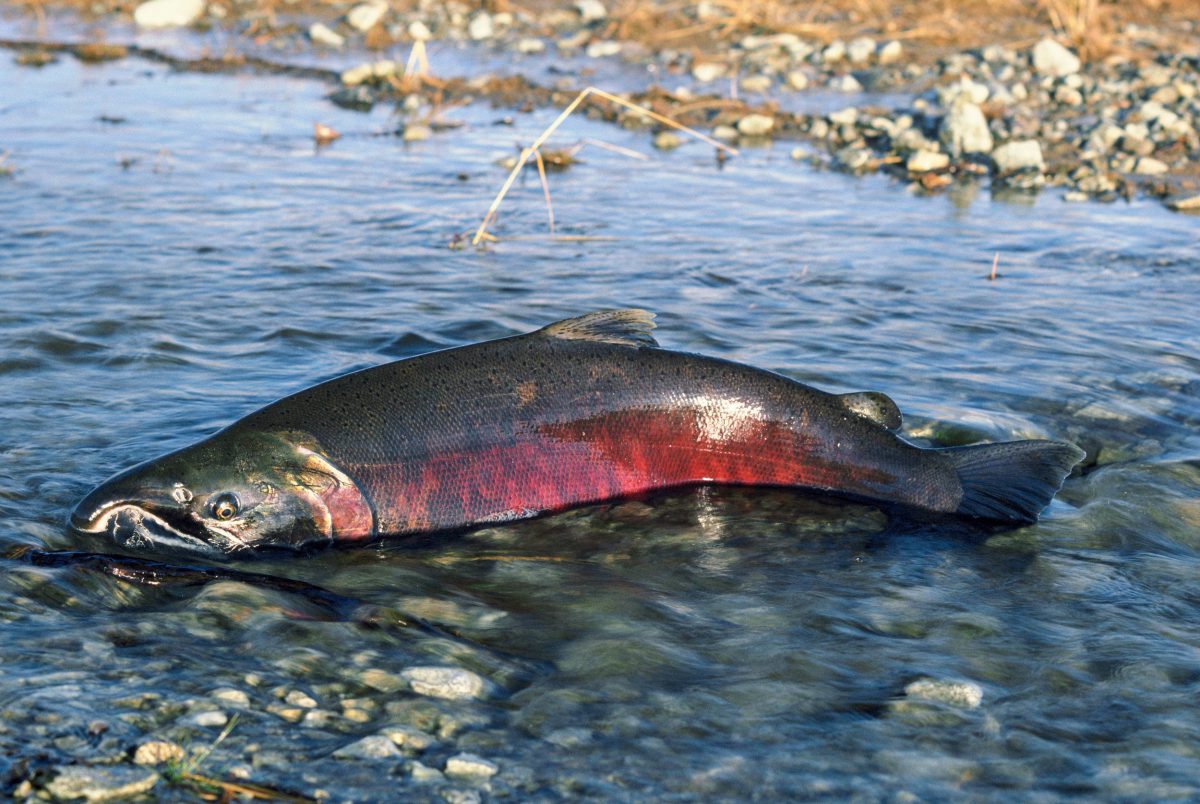
To return to Nez Perce country, coho salmon muscle their way up the Columbia and Snake Rivers for 800 kilometers, clearing eight dams in the process. Photo by BLM Photo/Alamy Stock Photo
But such successes are tempered by perspective. At the time of the treaties, in the mid-19th century, salmon reportedly formed half the daily calories of the Nez Perce, says Joe Oatman, a Nez Perce himself and the fisheries department’s deputy manager. These days, each of the tribe’s 3,500-odd members are lucky to get two salmon for the whole year.
“What was reserved by treaty is not what we are getting,” he says. “We are doing the most to try and bring these fish back and we are benefiting the least.”
“At the end of the day for us, it’s about our food,” Oatman concludes. “We have hatcheries, and that is the tool that we have, and we’re looking to do everything we can to use that in a wise way … But we do know we need to meet the needs of our people.”
For the Nez Perce, their hatchery fish are helping them just barely hold the line as a salmon nation. But they did not sign treaties ensuring the right to only two salmon a year.
While the Boldt Decision had an enormous effect on tribes in the United States, Canadian salmon people have had a different experience. Salmon populations are in a similarly dark place, for many of the same reasons, and it has likewise forced more Indigenous communities to rely on hatchery fish so they can practice their birthright, with 335 million young salmon released from hatcheries into Canadian waters each year. Though in Canada, of course, understanding the landscape of rights, fish, and First Nations requires a different map.
For starters, Canada-bound Pacific salmon may face the added stressors of potential disease and pollution from the dense aquatic sprawl of Atlantic salmon fish farms dotting southwestern British Columbia’s nearshore waters. Dwindling stocks in Canada only started to undergo review for protections under the country’s Species at Risk Act in 2016. And while there were limited treaties between Indigenous peoples and colonial powers in some parts of Canada, the vast majority of First Nations in British Columbia, for instance, never ceded their territories at all, much less in exchange for guaranteeing fishing rights, as was the case in the United States.
But First Nations eventually won legal protections of their fisheries, notably with a 1990 Supreme Court of Canada case known as R. v. Sparrow, in which the high court for the first time acknowledged Indigenous fishing as a constitutional right. The ruling further established priority for Indigenous food, social, and ceremonial rights to fish.
After the Sparrow case, Fisheries and Oceans Canada (DFO) funding for First Nations brought new cash for salmon restoration, monitoring, and more, according to Howie Wright, member of the Gitxsan Nation and former fisheries program manager for the Okanagan Nation Alliance (ONA) in British Columbia. ONA is a First Nations government based in the inland Okanagan region and represents eight communities sharing a common language. Most of those are First Nations based in Canada, but one—the Colville Confederated Tribes—lies in Washington. That relationship allowed ONA to build its own hatchery in 2014 with additional funding from Washington public utilities looking to offset impacts to sockeye salmon from their dams.
While Canada’s nearly three dozen hatcheries in operation today are run by DFO, First Nations, and community groups in British Columbia and Yukon, the federal government dominates the scene and ownership of the infrastructure. DFO spokesperson Mike Allison notes that “we have partnerships with 10 First Nations through the [Community Economic Development Program] to help support capacity for those nations to raise fish.”
Nitinat River Hatchery on the west coast of Vancouver Island, British Columbia, run by Fisheries and Oceans Canada, produces salmon for Ditidaht First Nation fisheries. Video by Kristina Blanchflower
According to Wright, ONA is the only First Nations government in Canada to actually own the building and license for its hatchery program, rather than DFO. Their facility rears sockeye for release into Skaha Lake and other lakes in the Okanagan Basin to revitalize the wild population that collapsed last century. Another grueling destination for salmon, Skaha Lake is fed by the Okanagan River, one of the Columbia River’s many branches, which cuts north through central Washington and across the international border. But its sockeye stock is beginning to recover and First Nations in the province are taking notice.
Given how involved the federal government is in hatchery management in Canada, Wright is quick to point out that many First Nations are eager to take more localized control over hatcheries to help restore the stocks where they live, rather than needing to travel to the coast to fish, where many hatcheries—and hence, fish—are located now.
Another issue with these large coastal hatcheries: “It’s almost like cattle farming, and they’re getting very homogenous populations that are developing just for hatcheries,” says Wright. And that is helping spur the early stages of a transition in how these facilities are run, with DFO developing specific genetic targets for hatchery stock and better protocols for assessing impacts on wild populations.
“I think right now in Canada we’re going through a transformative change, something that happened in the US, I’d say in the late ’90s, early 2000s,” Wright says. That era brought reforms to how US hatcheries monitor the fish released, manage the genetics of their broodstocks, and attempt to reduce interference with natural-born salmon. ONA’s hatchery management has followed the lead of its US compatriots, and is taking things a step further, one that could help other First Nations with their local salmon restoration goals.
“That’s where we look at having the hatchery-in-a-box,” says Wright. These modified shipping containers are insulated and outfitted with incubators and rearing tanks for tiny young salmon. The six- to 12-meter-long mini-hatcheries can be trucked into remote areas where constructing a large, permanent building isn’t desirable, but where First Nations still want to boost fish populations in specific places, as long as power and water are available. ONA has deployed 10 of these portable, impermanent—and starting at CAN $75,000—more affordable hatcheries-in-a-box so far, with more on order, for First Nations.
“It shouldn’t be the only tool,” he emphasizes, “but it’s one of the tools that First Nations can use in terms of salmon recovery and supporting fisheries.” Long term, he says, as First Nations progress in recovering salmon, their leaders will have to weigh how to wield that tool. In some places, habitat restoration can only go so far before running into ports and parking lots. Then, these leaders need to consider how resorting to hatcheries—when carefully run—may help bring salmon back to salmon people, without compromising the wild fish that are still managing to come home.
For the past few decades, as the number of wild fish returning to the Nisqually River has shrunk, a late-summer run of hatchery chinook has kept salmon in the nets and on the plates of Nisqually people. The river’s true—and uniquely adapted—wild chinook run went extinct in the 1960s, eventually replaced by a hatchery-descended population from another river. But even the Nisqually’s own hatchery population survival is tipped downward these days. David Troutt, the tribe’s natural resources director, sums it up bluntly: “Habitat limitation is the absolute limitation on the ability to produce hatchery fish and have adults come back.”
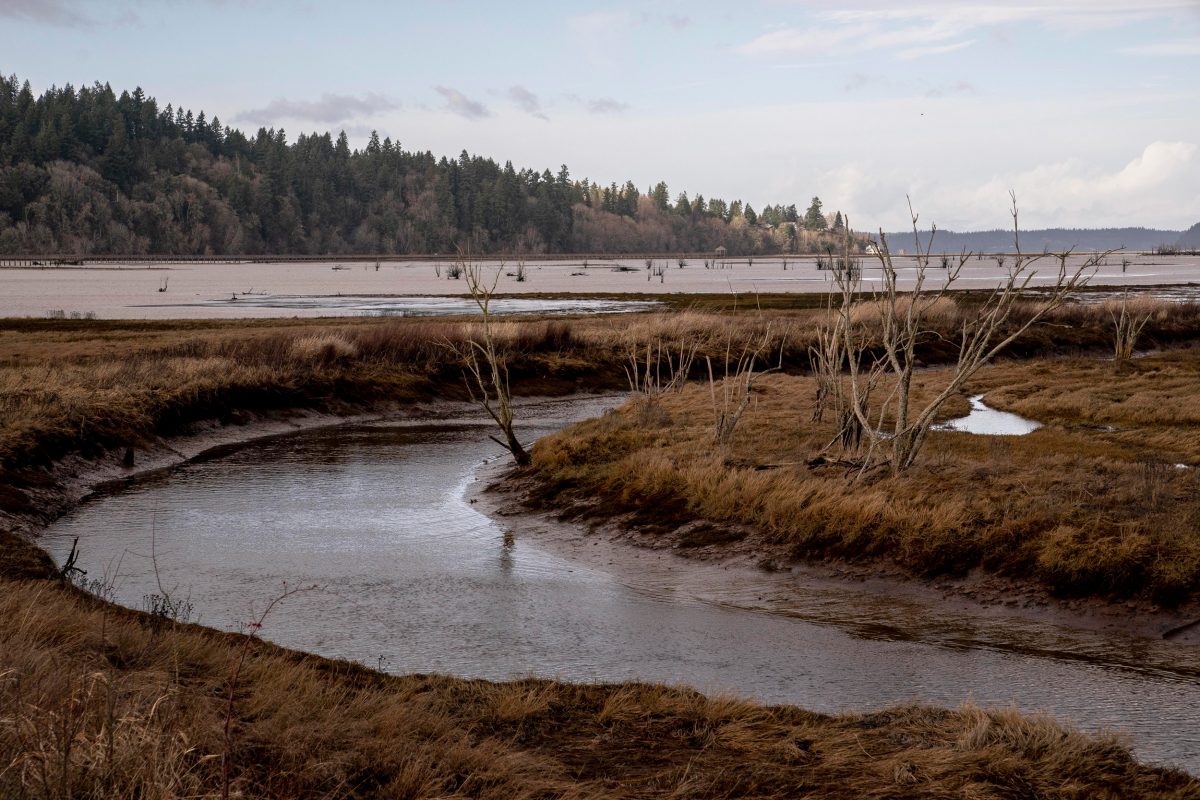
The Nisqually people have been restoring the Nisqually River delta for decades. Photo by David Ryder
In theory, the tribe could crank out eight million young chinook from its hatchery, but those tender smolts need a safe and suitable home in which to grow up as they journey toward the ocean. While the now-restored Nisqually River delta is ideal for that, Troutt likens it to a hotel with limited vacancy. And under the Endangered Species Act, they have to reserve enough hotel rooms for wild fish, including those from elsewhere in the south Puget Sound that can’t resist the Nisqually’s luxurious accommodations as they pass by. “We’re basically at capacity across Puget Sound,” he says.
Another effort to balance the changing needs of hatchery and wild fish under the Endangered Species Act is pushing the Nisqually to experiment with traditional gear types that give fishers more control over which fish they catch. The aim is to catch more hatchery chinook—which are all marked with fin clips, and some are tagged—and safely release any naturally spawned fish. But such a transition will not come easily for some old-timers who excel at setting gill nets. Still, the tribe’s natural resources department sees promise for keeping gill nets, with a few key tweaks, and even more promise among the next generation of Nisqually fishers, who seem more open to such change. And young fishers would have few options to get started at all without hatchery fish.
Nowadays at Frank’s Landing, Billy Frank Jr.’s reclaimed canoe hangs with pride from wooden beams inside the Wa He Lut school—itself erected the year of the Boldt Decision. Here, Native American children can parade underneath, learning stories of salmon once so abundant they glimmered like stars in the water.
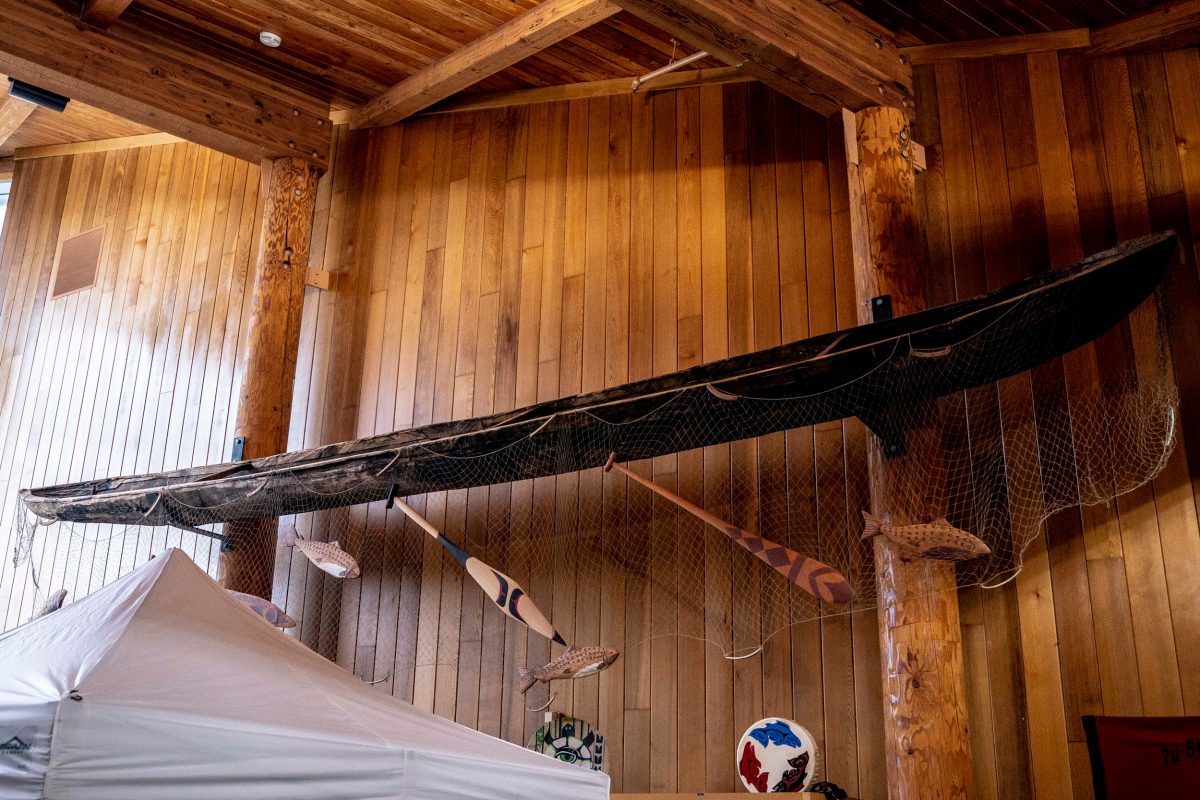
Billy Frank Jr.’s reclaimed canoe hangs from the rafters of the Wa He Lut school. Photo by David Ryder
Frank Jr.’s son is adamant that those stories aren’t reduced to memories. “[As] Hanford [McCloud] said, we don’t want to be that generation that catches every last fish,” Frank III says. “We need to be the ones who protect it.”
For tribes today, that protection also means ensuring those largely responsible for salmon’s decline live up to the promises of the treaties, the agreements that their ancestors understood would last for “as long as the rivers run.”
Today at Frank’s Landing, a red-and-white sign glares defiantly from the riverbank: “Absolutely no fishing, no exceptions.” But this time, the “no fishing” sign isn’t meant for the tribes.
Correction: Due to an editing error, we mistakenly stated that Wild Fish Conservancy debated the issue of salmon hatcheries with Nisqually tribe members at a film viewing. We regret the error.
*This story has been updated to include a statement from Wild Fish Conservancy.

